
> home page
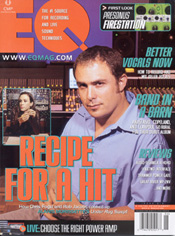
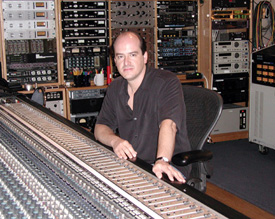
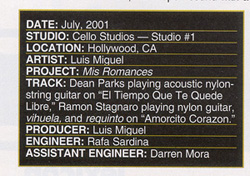
June 2002,
page 40
SESSION FILE
Luis Miguel Latin Guitar
By Lisa Roy
Getting the right string
sounds for guitars and other traditional instruments.
"For acoustic and nylon guitar recording the whole approach depends on the style of music that is being recorded and by the final results that we want to attain," shares Rafa Sardina, referring to his recording techniques on Luis Miguel's Mis Romances. "For this particular album I had to record a few different styles of nylon guitar that range from traditional nylon to more ethnic variations of the instrument. Dean Parks played most of the tracks that featured the more traditional style. Recording Dean is always a pleasure since he is a definite master of the instrument. The main tracks that he played on called for a very open and melodic nylon guitar solos. I recorded Dean at Cello Studio #1 (former Ocean Way Studio 1). This room in particular, because of its large dimensions, has a very clear and open sound with a very well defined ambience that highlights the high-ends of the instrument," compliments Sardina, who has earned two Grammy's for his work with Miguel.
Signal Path
"I recorded the guitars to analog, and simultaneously to (Digidesign) Pro-Tools through Apogee AD-8000 Special Edition converters," reveals Sardina. "I used this recording strategy since we needed to do some edits on the fly in case any last-minute ideas pop up. It is always nice to be able to do edits without disturbing the flow of the session, and Pro-Tools is an irreplaceable tool for that."
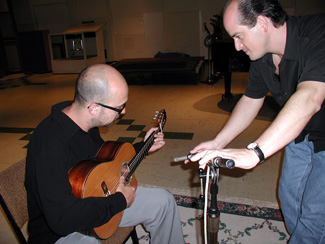
Rafa
sardina adjusts the mics at Cello studio #1 with
the help of an assistant
MICPOSITION
"Dean performed close to the center of the studio, slightly off to one side. For these tracks I tried a few different mics since trial and error is still the most effective engineering technique I have ever found," explains Sardina. "The mics I selected were some of my favorites for nylon guitar, a Neumann KM-54, an AKG C-12, and a Neumann U-47. My final choice was a vintage Neumann KM-54 tube for most of the tracks, an all-time favorite! This is a microphone that represents the instrument very clearly with an amazing amount of definition, very tight bottom-end, very crisp high-end and no harshness. You have to be very careful though, because with most KM-54s, being such an old tube mic, the sound variation between microphones can be very dramatic. The condition of the nickel capsule will fluctuate from mic to mic. So, it helps working at a nice studio that takes care of their mics and has a good selection of them.
I always experiment with the positioning of the microphone until I find the right spot for the adequate balance between fingering definition and low end. First I usually listen to the player while he plays the instrument and then I listen through a pair of headphones. That way I can really fine-tune the positioning and very quickly find that magic spot.
To capture the ambience of the room, I used a (Neumann) M149 at approximately 12 feet away from the source and about 10 feet high. Later on I used this particular track during mix-down to add some extra ambience and dimension to the guitar. It worked quite well!"
PROCESSING
"As for mic preamps, I used a pair of Mastering Lab tube preamps that I really cherish," proclaims Sardina. "These are some of the most amazing preamps I have ever used, and I only regret not having more for big tracking dates. It's a shame they don't make them anymore. These preamps have a great high end and an amazingly defined low end that is not commonly found on most preamps - even high quality and expensive ones. After the preamps the signal went to a stereo Avalon AD-2055 equalizer where I fine tuned the signal a touch and went straight into the Ampex ATR-124 analog machines. I don't use any compression at all.
"With such a great player and a really well balanced room, I didn't need any further processing. To me, this has always been the best way to guarantee a great recording. If you are not getting the right sound you have to re-evaluate your approach and start with the source. Always build your sound from the source up, and never the other way around. If you are reaching for the EQ or compression right away, there is no doubt you are doing something wrong.
"As I mentioned earlier, when we tracked guitars with Dean, we recorded several styles. For one of the songs, which was more of a rhythmic track, I ended up changing the mics. We decided to record the bass parts (fifth and sixth string parts) as a separate overdub to accomplish some fingering positions that were not technically possible in a single pass. I went for a tight sound and kept the KM-54 for the high parts. By tilting it and pointing it toward the neck I lowered the amount of low end being picked up. For the low part I ended up using an AKG C-12 that conveys a very smooth lows and mids. When I was mixing this particular track at the Record Plant, I used the automation to level every note from the bass. Automation rides are still the best form of compression available."
TRACK NOTES
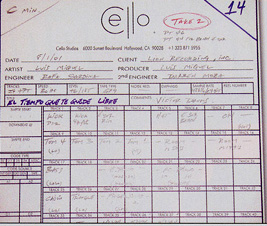
Sardina concludes, "One of the tracks on Mis Romances was a very traditional
style of Mexican music called mariachi, a departure from the pop latin sound
Luis' albums are known for. This style of music calls for a very festive layered
guitar sound. There were three very distinct types of guitars recorded for
this song; nylon guitar, vihuela and requinto. The foundation of the song
was based on the two guitars and the vihuela. The nylon guitar went down first
and I used a U-47 to record it. This style of playing can be quite busy and
I had to EQ slightly to shape the mid-lows so they wouldn't take an excessive
amount of room. The guitar was doubled to get a nice stereo spread.
"Afterward I recorded the vihuela, which is a small guitar equivalent in shape and size to a mandolin. This instrument projects a considerable amount of high end transient material with a moderate amount of low end on its sonic content. In this case I opted again for a Neumann KM-54, which captured the sound of the instrument without having to use any EQ at all. The vihuela was also doubled.
"To finish off, we
recorded the lead parts, which are traditionally recorded with the requinto,
a smaller-than-usual nylon guitar that comes from Chihuahua, Mexico. This
guitar has a very distinct high end sounding character, which the KM-54 captured
phenomenally. I used some compression on the requinto during mixing. Here
is an exception where I tend to compress the instrument for character. I used
an (Teletronix) LA-2A to shape the high end of the instrument. I place it
post EQ so I can boost the very high end of the requinto from 12KHz up for
some nice definition and then compress it to compensate for some of the harshness
that might result. This combination really makes the sound of the requinto
sizzle."